Solving Common Summer Lawn Drainage Issues
Summer brings longer days, plenty of sunshine, and usually more time spent outdoors. But it can also bring water issues that mess with your lawn. From soggy patches that never dry out to sections of grass that turn yellow or die off, drainage problems can sneak up and cause a mess before you know it. These issues aren’t just annoying to look at. If left untreated, they can lead to deeper damage and make outdoor spaces less enjoyable.
Taking care of drainage concerns during the summer is a smart move for any homeowner. The warmer months are when your lawn is most active, and proper drainage helps roots breathe and grow. Catching problems early keeps your yard stronger for the long haul and can even protect your house from water damage. Learning what to look for and understanding why it’s happening is the first step to making improvements that last.
Identifying Drainage Problems
Some drainage issues are easy to spot. Others take a little closer attention. Either way, it helps to know what to look out for so you can catch it before your lawn is in trouble.
Here are some common warning signs:
– Water pooling in the same spots after each rain
– Mushy or spongey areas when you walk across the yard
– Blades of grass that are turning yellow or thinning out
– A musty smell that sticks around long after it rains
– Puddles around patio edges, sidewalks, or near the foundation
Sometimes, these appear during heavy summer storms and seem to resolve after the water dries up. But if the same areas always stay wet or your lawn doesn’t bounce back like it used to, the problem might be more than just a heavy downpour. It’s important to walk through the property occasionally to check for changes you might overlook during your daily routine.
Common Causes Of Lawn Drainage Issues
Once you’ve spotted a problem, it helps to figure out what’s causing it. Most lawn drainage issues come down to a few common reasons. Knowing what those are can help you plan your next step.
1. Soil Compaction
When soil gets packed down too tightly, water can’t move through it like it should. This usually happens in yards that see a lot of foot traffic or heavy equipment. When the soil is too dense, water sits on the surface instead of soaking into the ground.
2. Thatch Buildup
A thick layer of thatch, which is the layer of dead grass and roots between the soil and living grass, can block water from getting down to where roots need it. Over time, this buildup traps more water at the top, making drainage worse.
3. Poor Grading or Slope
If your lawn isn’t sloped correctly, water will sit still instead of flowing away. Even a small low spot or wrong angle can lead to pooling. This can happen in both older homes and new builds that aren’t properly leveled.
4. Overwatering or Irrigation Issues
Sprinklers that run too long or too often can drown your grass. Also, irrigation heads that are poorly placed can leave some areas flooded and others dry. This quickly leads to uneven grass health and waterlogging in certain spots.
These causes may seem simple, but if overlooked, they turn into bigger problems. Some can be adjusted with small changes, while others may need long-term fixes to restore proper drainage.
Effective Solutions For Improving Lawn Drainage
Fixing drainage problems depends on what’s causing them, but there are several proven methods that often help restore balance to your lawn. Some are simple steps, while others may reshape parts of the yard. Either way, taking the right approach leads to fewer problems and stronger lawns.
Here are some helpful drainage solutions:
– Aerating the Soil
Aeration is a great way to treat compacted soil. It breaks up the ground so water can move more freely toward the roots. Heavy-traffic spots, such as walkways or common play areas, benefit the most from consistent aeration.
– Adding French Drains or Dry Wells
For lawns that hold water in the same places time after time, a French drain or dry well can move the extra water away from the yard. These solutions work without disturbing the rest of your landscaping.
– Mixing in Organic Material
For soil that holds water too tightly or drains too fast, adding compost, mulch, or other organic matter can create better texture. This helps water soak in just enough to nourish the lawn without staying too long at the surface.
– Regrading Portions of the Lawn
When water moves toward your home or stays trapped in low spots, regrading might be needed. Changing the slope slightly helps push water away from the foundation and clear up standing puddles. Since regrading involves soil work and measuring slope angles, it’s important to let professionals handle it.
– Fine-Tuning Irrigation Practices
Even well-placed sprinkler systems need adjusting now and then. Check how long each zone runs and whether the placement fits the natural drainage patterns of your yard. Shortening watering times or changing the layout can help fix patchy areas or prevent overwatering.
A well-drained yard costs less to maintain, looks better, and feels comfortable underfoot. Even a small improvement, like installing a short drainage line behind a garage or adjusting one sprinkler head, could fix a lingering problem that’s been ruining part of your lawn for years.
Why Professional Help Makes a Difference
Not all lawn drainage issues can be solved by guesswork. While some fixes are pretty basic, others require a deep understanding of the property conditions, water flow, and soil makeup. That’s where an expert lawn care service like Ryan Lawn & Tree can make a real difference.
When you work with our team, we take the guesswork out of the process. We look at everything from your yard’s natural slope to the type of grass and soil that makes up your lawn. Lawn drainage problems often need a custom solution — not just a generic fix.
If you’ve got grading challenges or need underground drainage systems, it’s much safer and more efficient to rely on professionals. You’ll save time by avoiding trial and error, and often save money in the process. One correct fix can last much longer than multiple smaller attempts that miss the mark.
Our focus is on long-term solutions. We make sure the drainage issues you face this summer don’t return year after year. That means less soggy turf, fewer muddy shoes, and more time enjoying your yard without stress.
A Better Lawn Starts With Quick Action
Timing is everything when it comes to fixing lawn drainage issues. If you wait too long, a small puddling problem can grow into soil damage, lawn thinning, or even issues around your home’s foundation.
The good news is that most drainage problems are manageable — especially when caught early. Your lawn is made to grow, bounce back, and stay strong. But it needs the right setup to do that. A properly draining lawn dries out evenly, supports grass growth, and keeps your outdoor space feeling clean and lush.
If you notice slow-to-dry spots, yellowing turf, or water collecting in low areas, now is the time to take action. Fixes done in the summer give your lawn a better shot at staying strong through the season and make future weather challenges easier to handle. When your yard works the way it should, it becomes a space you want to spend more time in.
Identifying the signs, understanding the causes, and taking smart steps toward a solution leads to a lawn you can be proud of — green, soft, and mess-free all season long.
For quality lawn care services that manage lawn drainage issues effectively, consider consulting with Ryan Lawn & Tree. Our team understands the intricacies of keeping your yard healthy and vibrant throughout the summer. Don’t let water problems dampen your outdoor enjoyment—connect with us to explore solutions tailored to your needs.









